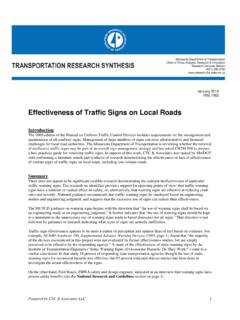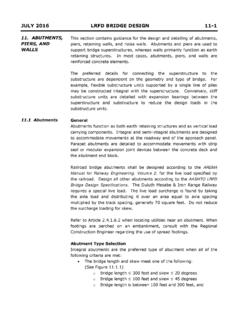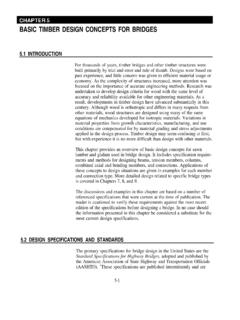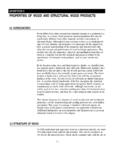Transcription of PROPERTIES AND MIX DESIGNATIONS - Minnesota …
1 September 1, 2003 CONCRETE MANUAL PROPERTIES AND MIX DESIGNATIONS PROPERTIES OF CONCRETE Inspectors should familiarize themselves with the most important PROPERTIES of concrete: workability durability strength volume change air entrainment density All of these affect the finished product and knowledge of these PROPERTIES is essential to produce a quality final product. Each property is explained below. WORKABILITY Workability is one of the most important of these PROPERTIES .
2 The degree of workability necessary in a concrete mix depends entirely upon the purpose for which it is used and the methods and equipment used in handling and placing it in the work. Inspectors must use their best judgement in determining the workability of the concrete and must make any adjustments to the mix that is necessary to improve the workability in accordance with instructions in this Manual and the Specifications. Indicate any adjustment in the mix (such as the addition of water, cement, or admixtures at the job site) on the Weekly Concrete Report (Form 2448) to provide information for possible mix design adjustments by the Mn/DOT Concrete Engineering Unit.
3 The factors that affect the workability of concrete are size distribution of the aggregate, shape of the aggregate particles, gradation and relative proportions of the fine and coarse aggregate, plasticity, cohesiveness, and consistency of the mix. These factors were all given careful study and investigation at the time the design procedure now in use was established. The proportions of the fine and coarse aggregate are determined from the shape of the aggregates and the gradation. For instance, a large rock size coarse aggregate that is mainly crushed will permit the use of larger size sand particles and maintain good workability.
4 Well-rounded gravel will have better workability with finer sand, which is needed to fill the smaller void areas. These ideal conditions are seldom found and the mix design requires adjustments to compensate for variations from the ideal conditions. The consistency of the mix, relative to the wetness or dryness, will affect the workability to a large degree. Do not increase the water content beyond the tolerance allowed in Specification without adjustment in the mix design. Adding water in any amount with no control will produce poorer concrete, lowering its strength and durability.
5 The finest materials contribute to the plasticity and cohesiveness of the mix, mainly the cementitious portion of the concrete (cement, fly ash , ground granulated blast furnace slag, and silica fume). The cementitious content, however, is usually fixed by other considerations. Air entrainment greatly improves plasticity and cohesiveness. The entrained air in the form of small September 1, 2003 CONCRETE MANUAL air bubbles acts as a lubricant or ball bearings between the aggregate particles making the mass more workable.
6 DURABILITY The ultimate durability is the most important property of concrete. To ensure a high degree of durability, it is essential that clean, sound materials and the lowest possible water content are used in the concrete, together with thorough mixing. Good consolidation during placement of the concrete is important, as are proper curing and protection of the concrete during the early hardening period, which assure favorable conditions of temperature and moisture. Cure concrete properly for a minimum of three days in order to develop good durability.
7 Another property that helps ensure durability is the water to cementitious ratio (w/c). The term w/c in this publication refers to weight of water divided by the weight of cementitious material. Cementitious materials include portland cement, slag, silica fume, fly ash , and any other material having cementitious PROPERTIES as approved by the Engineer. While strength is always an indicator of quality concrete, it does not necessarily correlate to durable concrete. A low w/c ratio is a good indicator of durable concrete. A general characteristic of a low w/c ratio is that an acceptable strength is usually inherent.
8 The overall voids left in the concrete by excess water are kept to a minimum by keeping the batch water and any add water to a minimum. This gives a more dense concrete along with a more durable and stronger mix. A good air void system is also essential to having a durable concrete when the concrete is exposed to freeze-thaw conditions. Concrete having a total air void content of about seems optimal. A mix having total air voids will have approximately entrapped air voids and entrained air voids. Entrapped air is the larger bubbles formed in the mixing process and does not provide much protection against freeze-thaw action.
9 The entrained air bubbles are smaller and more closely spaced. These small bubbles give protection against freeze-thaw. Concrete with entrained air will have a lower strength than the same mix without entrained air, but the concrete can attain strengths required for most purposes by an increase in the cementitious factor of the mix or by reducing the water content. strength The strength of concrete is the next important property to consider. With a fixed amount of cement in a unit volume of concrete, the strongest and most impermeable concrete is one that has the greatest density, , which in a given unit volume has the largest percentage of solid materials.
10 The use of the absolute minimum quantity of water required for proper placement ensures the greatest strength from the concrete. It is essential that freshly mixed concrete be thoroughly consolidated to eliminate air pockets and secure maximum density in the structure. The Engineer must prevent the occurrence of loosely textured or porous concrete matrix called honeycombing to achieve maximum strength and 1, 2003 CONCRETE MANUAL (1) The degree of curing and protection afforded after placement is highly important to the final strength attained by the concrete.









